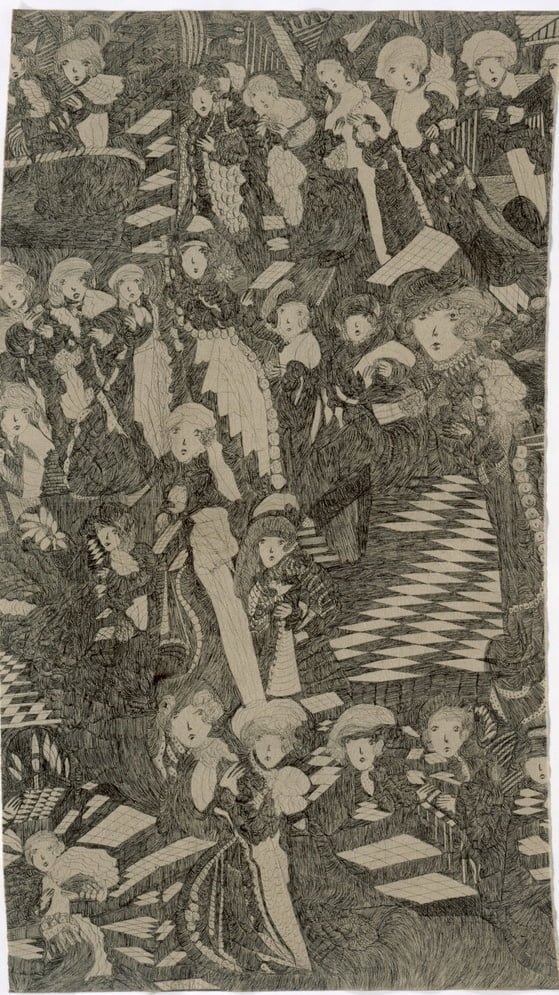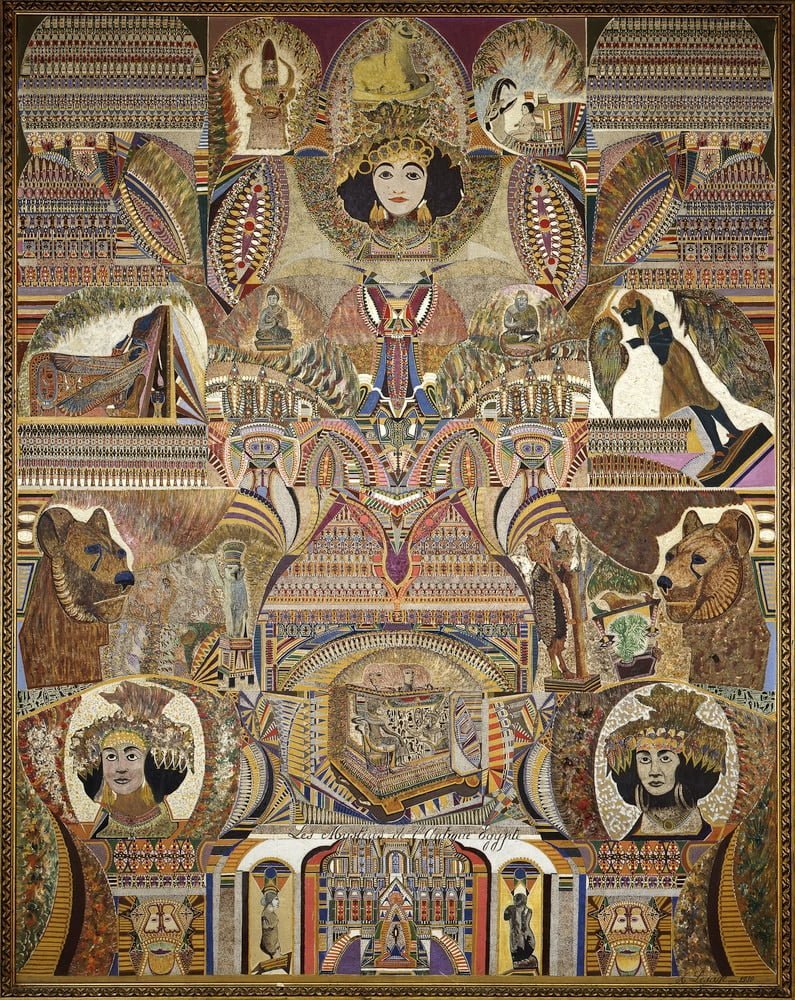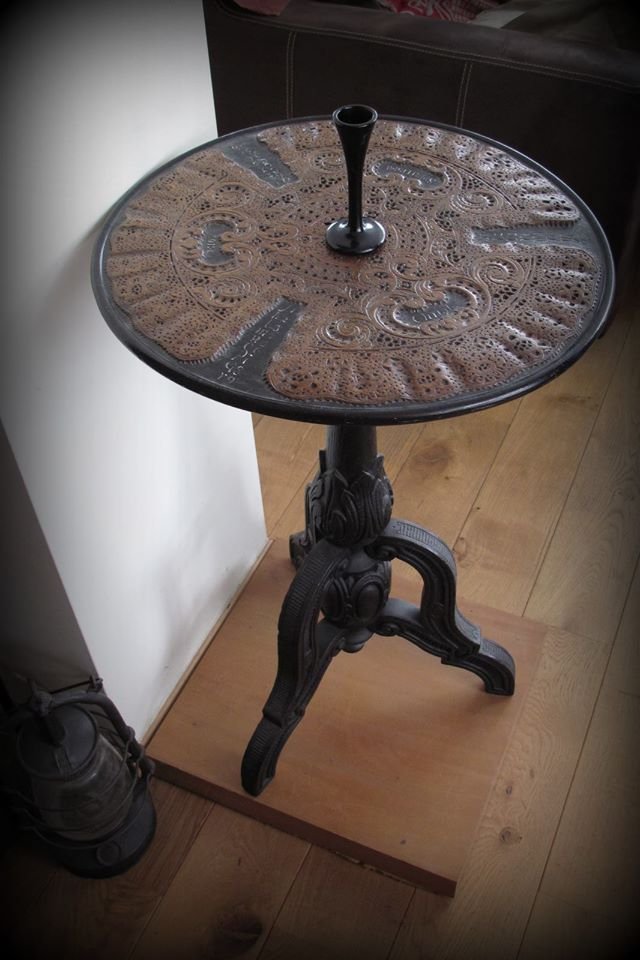Does artistic inspiration come from beyond?
“The position of the artist is humble. He is essentially a channel”. Ts These are the words abstract painter and theosophist Piet Mondrian chose to define creation. What if artistic endeavours were merely a rendition of a message from beyond? But from where though? a transcendent entity, the source, God?
The “Spirit, are you there?” exhibition at the Maillol museum in Paris seems to confirm this viewpoint. It showcases the work produced between 1912 and 1976 by Augustin Lesage, Victor Simon and Fleury Joseph Crépin. How can it be, that a miner, a café owner and a plumber started painting with no formal training whatsoever and having never displayed any prior artistic inclination?
Nothing had destined them to become artists. Yet all three heard the voices of spirits guiding them from beyond to produce an astonishing and prolific body of work. The exhibition allows us to discover these impressive “channeled” paintings while giving them some context.
What is spiritualism?
American Spiritualism first appeared in 1848, after the three Fox sisters claimed to have come into contact a deceased person in their “haunted” house in Hydesville, Wayne County, New York. The craze for communicating with spirits quickly spread to Europe. In the United Kingdom, Sir Arthur Conan-Doyle’s interest is well documented. In France, the phenomenon – renamed “spiritisme” in 1857 – also fascinated illustrious writers such as Victor Hugo or scientists like Pierre and Marie Curie.
The first room in the exhibition shows a selection of objects used by mediums to communicate with spirits. In addition to pendulums and tarot cards, ouija boards were used to guide their users’ hands towards letters. A more surprising object is the “spirit hand” which, rather like telegraph between two realms, made it possible to translate tapping into messages, using Morse code. Further on in the exhibition, a remarkable pedestal table with a turntable is on display. Dating from around 1864, it bears alphabetical inscriptions to enable the rapid transcription of strokes into letters, and then words.
Highly fashionable in literary and scientific circles, spiritualism merged with with pre-existing therapeutic practices and esoteric currents, such as theosophy. But it also integrated popular culture and became a social phenomenon, as demonstrated by the silent film The Medium Exposed (1906), also projected in the show.
Three unlikely spirit artists from Northern France
At the beginning of the 20th century, spiritualism became very popular in the North of France – perhaps due to death being a fairly regular occurrence in this coal-mining area, which was also severely affected by the two World Wars.
The three artists featured in the “Spirit, Are You There?” exhibition knew each other and were friendly. Their works were even exhibited together in a Parisian gallery in 1946. But despite their many similarities, Augustin Lesage, Victor Simon and Fleury Joseph Crépin each developed a unique style and career.
Augustin Lesage (1876-1954): coal-miner and spirit medium
Following his family tradition, Augustin Lesage started working as a miner aged 14. At the end of the year 1911, he was working in a remote area of the mine, when he heard a voice uttering “One day you shall be a painter”. Initally petrified, he told no one. However, in the autumn of 1912 he attended a seance and was appointed medium. He subsequently created three “automatic” drawings showing sinuous, vibrating shapes. He signed them “Marie”, as he had apparently been guided by the spirit of his sister, who had died in 1883 at the age of 3.
Lesage declared “Nothing in my work is by me… The spirit uses my hand directly.” The voices promptly requested that he switch to painting, telling him which canvas and brushes to acquire, as well as the colours and shapes he needed to materialise. These became increasingly geometric as time went on, integrating stylised plant motifs and architectural structures.
In the Enigma of the Centuries, as is often the case in Lesage’s paintings, the composition is arranged symmetrically around a central axis. Resembling a large temple seen from a bird’s eye view, it is made up of seemingly abstract elements. A closer inspection, however, reveals windows or arcades, interwoven with purely geometric patterns.
Lesage initially painted at home, alongside his day job and practice as a healer. When he sold a painting, he would set its price based on a miner’s hourly wages. Due to lack of space, Lesage painted his large formats in successive areas, unrolling his canvas as he went along. In 1923 he devoted himself exclusively to his art and, thanks to his success, he was able to travel and participate in foreign exhibitions.
From 1928, Lesage incorporated faces, as well as Egyptian artefacts, probably after seeing some at the Louvre. The Mysteries of Ancient Egypt (1930) notably combines a gilded wooden statue discovered in Tutankhamun’s tomb in 1922, the face of Queen Puabi, associated with the royal tombs of Ur, as well also Greek and Roman statuettes and two images of the Buddha.
In 1946 he declared: “My only joy is to have a brush in my hand, and to be constantly under the influence of these planetary artists.”
Victor Simon (1903-1976): the quest for a 'universal temple'
Lepage saw Victor Simon as his artistic heir. Although he had experienced visions and heard voices from an early age, Simon began working in the mine before getting an office job. He developed an interestin philosophy at age 16 and got involved in spiritualist circles. In 1933, while he was running a café in Fouquières-Les-Lens, he created his first guided drawings before receiving the apparition of seven faces which spoke to him thus: “You must paint, you must paint a canvas of four meters over two and get to work before the end of July.” On 31 July 1933, and despite having never even held a brush in his life, he began his first painting, called Resurrection, unfortunately lost today.
Victor Simon subsequently produced hundreds of small canvases and a dozen large formats that he counted in square meters, since he was designing his universal temple: “over 70 square meters of teaching”, he said. In his paintings, arabesques merge with geometric patterns, evoking Byzantine art, medieval illuminations, Persian carpets or even Hindu panels: an array of “impossible to decipher hieroglyphs . “
Human and religious figures are also apparent in his work. The impressive Judeo-Christian Canvas brings together the faces of Jesus and Moses, supporting a temple of knowledge, the entrance to which is guarded by two protective panther’s heads. Although the composition seems symmetrical, the decorative patterns are actually different on either side. The painting, which marks a step towards a more universal religion, remained hidden for fifty years before being restored for the exhibition.
Like Lesage, Simon also practiced as a healer, and his talents were renowned as far as North Africa. In 1947 he founded a journal named Forces spirituelles, which he took care of until his death. This publication enabled him to write analyses of his pictorial works. Finally, the spirits entrusted him with another task: to write three books. In under three months, Will he return? was published, followed in 1955 by From the sixth sense to the fourth dimension and in 1957 by From the unknown self to the unknown God.
Fleury Joseph Crépin (1875-1948): painting for world peace
After graduating from school in 1888, Fleury Joseph Crépin led a successful career, alongside his father, a range of trades: he worked as a locksmith, blacksmith, plumber and zinc worker, driller. He was also a talented musician and practiced the clarinet at a high level. But it was not until 1931 that a friend initiated him into the spiritualist circle of Douai.
Crépin then became aware of his gift as a hands-on healer and cured many sick people. But his turning point as an artist came in 1938, when one evening he lost control of his hand while he was copying some music and it began drawing. The following year, he began to paint.
In 1939, a 63 year-old Fleury Joseph Crépin heard voices saying: “Once you will have created 300 paintings, the war will be over on that day. After the war, you will produce 45 wonderful paintings and the world will be at peace.” His first oil on canvas was signed, numbered and dated March 25, 1939. He painted throughout the war, following his guides, and signed the last one on 7 May 1945, the day before the armistice.
One of Crépin’s most recognizable elements are the embossed droplets, which he said he could create at the rate of 1,500 per hour. The patterns evoke neo-Byzantine architecture, combining geometric shapes with figures painted in a naive style.
After the victory of the Allies, Crépin sent a painting to Montgomery, Stalin, Eisenhower, General de Gaulle and General Zhukov (liberator of the city of Berlin). His postwar artwork incorporates flags with butterflies, trees and crosses.
Crépin’s work was shown in Paris, at the Lefranc gallery in September 1945, and again in 1946 alongside Lesage and Simon, at the initiative of the French Spiritualist Union. On this occasion, he caught the attention of Jean Dubuffet, the inventor of art brut. In November 1947, a few paintings by Crépin were noticed by André Breton (who acquired two) and Victor Brauner, who regarded his works as a perfect response to the surrealists’ search for automatism.
In November 1947, he made a start on his series of 45 wonderful paintings, which was meant to pacify the world. He left two cavases unfinished when he died on 10 November 1948, thus making durable peace on earth impossible…
Universal forms and spirituality
On the ground floor of the exhibition, large formats, including Victor Simon’s stunning Blue Canvas, are placed near authentic Jain or Nepalese Buddhist mandalas. From the Sanskrit word for “circle”, mandalas were used as meditation tools, to focus the attention of the devotee. This parallel is all the more surprising given that Victor Simon, like Lesage and Crépin, did not have access to this type of work. This poses the question of the existance of universal, autonomous shapes, which could transcend geographic borders.
The artistic legacy of Lesage, Simon and Crépin, seems to extend into the works of Christian Allard (the great grandson of Augustin Lesage) or Stéfan Nowak. Their paintings display a similar sense of aesthetics, combining symmetry, geometry and repetition of patterns, and even Lesage’s characteristic droplets.
Spiritualism in 'professional' artists
The “Spirit, are you there?” exhibition also honors creations made by established and renowned artists, such as Théophile Bra.
Far from being self-taught, this major sculptor of the romantic era encountered some family issues in 1826, after which he produced nearly 5,000 drawings resulting from what he called “creative somnambulance outbursts”. They reflect his penchant for the occult, freemasonry and religion, both Judeo-Christian and Oriental.
Under the influence of “psychelia” that guided his hand, he filled his pages with figures, abstract motifs and philosophical and metaphysical texts. Haunted by different spirits, he drew their faces, including that of Swedish visionary Emanuel Swedenborg.
The importance of women in spiritualist circles
Many women played an important part in the world of spiritualism, and spiritualist art. Their role is all the more interesting as it seems to have allowed a form of emancipation for many of them.
Elise Müller, also known as Hélène Smith, born in Geneva in 1861, discovered her extraordinary gift as a medium at the age of thirty during a spiritualist seance. The psychology professor Théodore Flournoy transcribed some of the somnambulist dreams experienced by the young woman. In a state of trance, Elise Müller recounted her reincarnations as the wife of a Hindu prince or as Marie-Antoinette. In 1894, she narrated her first journey to the planet Mars.

Between 1905 and 1915, she painted a series of pictures dictated by voices from Heaven, using her fingers. The Daughter of Jairus is surprising by its purity and closeness in appareance to the naive art of Douanier Rousseau. The work was supposed to have healing and regenerating powers. In 1933, works by Müller were reproduced in André Breton’s article “The Automatic Message”, which appeared in the surrealist journal Minotaure. The artist herself, meanwhile, was depicted by Victor Brauner as a Mermaid, a figure associated with knowledge.
Among the other fascinating women shown in the exhibition, Mme Bouttier is worthy of note. This mysterious woman from Lyon was close to spiritualist circles. Her automatic drawings seem to render stylized leaves and insects as if they were being looked at under a microscope.
Finally, English artist Madge Gill, she began a compulsive production of ink drawings in 1919 , following a seance. Produced under the guidance of a spirit she called “Myrninerest”, her drawings stage female faces interwoven with arabesques and distorted chessboard patterns. Indeed, only once she had scribbled lines in all directions did she make the faces appear…
Spiritualist tendancies in contemporary art
Around 10 million people still practice spiritualism today, particularly in Brazil. But the specifically spiritualist process of channeling a higher source, can also be found in the work of several visual artists of our time. Rainier Lericolais, for instance, aims to reveal the invisible and the unaudible. The work Toupie / Spinning Top (2016) consists in a glass plate coated with soot, which bears the traces of the movements of a spinning top thrown several times. It simultaneously records a phenomenon that eludes the artist’s gaze, while presenting a seemingly random drawing, but that is perhaps guided by rules beyond our comprehension?
As for the artist Timon Nasseri, his works reveal his double culture: he was born to an Iranian father and a German mother. The One and One # 2 drawing combines four different triangles to create unique designs, drawn in white ink on black paper. The geometric pattern evokes muqarnas vaults, typical of Islamic architecture. The effect recalls the ideal architectures designed by Augustin Lepage or Victor Simon.


















